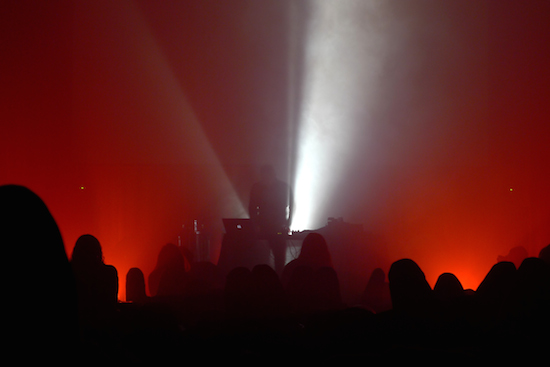Photo by Paul Clipson
Open Frame is an annual festival held by Room40. This year, it extended to Sydney’s Carriageworks – an immense industrial rail yard complex repurposed as an arts venue.
Label head Lawrence English stands tall in a black ten-gallon hat at the back of the room. Those expecting to see Jim O’Rourke perform are out of luck – English tells us O’Rourke doesn’t care to leave Japan and proceeds to perform the piece on his behalf.
Diffusion presents four channels of audio in tangled dialogue with one another. It best resembles O’Rourke’s Old News compilations on Editions Mego, layering found sound and modular synth with manipulated acoustic instruments.
O’Rourke’s sense of play saves it from chaos. At one point, the rear stereo image pairs a burgeoning furnace of noise with an arpeggio that spins like a spitting Catherine wheel. Later, a grainy synth pulse contrasts insectoid filigree and ghostly bass, as though you’re listening to a B-grade 80s sci-fi screening next door. A recurring koto melody makes a wry joke of O’Rourke’s refusal to leave Japan despite English’s repeated requests.
Filmmaker Makino Takashi’s performance takes a sterner tone. The music builds shimmering layers of noise over a menacing drone. Using two projectors – one digital, one analogue – Takashi overlays a blizzard of red and white shapes onto a large screen.
Through single-lens 3D glasses, the many depths of field within the film appear as familiar motifs. Reverse the frames, and these associations disappear as the patterns become mirrored, flowing in opposite directions. The intricate details are incidental, impassive; beautiful but unknowable.
Chris Abrahams and Lousie Curham’s collaboration is more welcoming. Abrahams teases harmonics from a single piano note before burrowing deeply into the instrument to produce lush harmonic clusters. Curham tends four projectors that present a quadriptych against the pitted concrete and steel fittings of the right wall.
Her footage shows unremarkable scenes – rose gardens, dancing figures, text. The way she tends the projectors is beautiful. One burns through a shot of a back yard, causing light to bloom outwards from the lawn’s centre. Another loses the thread of its film and catches, stuttering audibly, on a single frame. Curham passes between them, coaxing the film, lending the impression the projectors are shuttles on some loom she’s using to weave light into the dark space.
William Basinski addresses us with flamboyant charm but becomes austere as he places the microphone down. Elegiac piano wells gently into the room, building in volume and gradually feeding into itself until contours fall away, leaving a monolith of glowing middle frequencies. This is intensely personal music. Its repetition hints at many things – impermanence, disintegration, the sublime – but is hermetic and ultimately turns your thoughts inward. We’re increasingly alone as the music blossoms, shedding its features to reveal only shapeless melancholy. Once the theme fades, there’s a palpable release – people exhale, stretch, stir, as if some great knot has loosed.
The festival’s second night opens with a commission from Robbie Avenaim and Austin Buckett, who tend a table stage left, looking out over the eccentric silhouette of Avenaim’s robotic percussion system, which sits between two fat Ampeg stacks. Their piece opens with a series of hits that punctuate furrows of bass. This high drama disintegrates when Avenaim triggers all the drums at once, creating the impression of a school ensemble trying to follow an elaborate score. The maelstrom takes on a gravelly quality, like you’d expect an avalanche to sound if you could travel with it, thundering down an incline before petering to pebbles.
English tells us to lie down for his set: "The floor is absolutely the place for this music, so get close to someone, get intimate – you never know where experimental music might lead." He envelops the audience in swollen bass and cascades of distortion, accomplished and dynamic, remarkable for the elegance and grace it manages at volume. For all its bombast and technique, the set is loveliest when the power ambience recedes, leaving you lying weightless in the dark.
The festival closes with Hypnosis Display, an audio/visual piece by Grouper and filmmaker Paul Clipson. The music resembles stretches of electric ambience on Alien Observer/Dream Loss, tempering distant static, muted vocals and layers of keyboard with snippets of dream narration, children laughing, traffic, whistling. It’s remarkable for how seamlessly it progresses, immersing the room in eldritch twilight.
Clipson’s film searches for incidental patterns in water and manmade structures. Its use of superimposition is overwhelming, plunging you into endless water textures, spiriting through buoyant city lights. The lulling music and billowing psychedelia of the film make you feel as though you’re hallucinating certain details, deceived by the contours of another person’s dreamscape. It’s surreal and intoxicating – an apt way to end such a festival.


